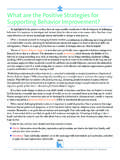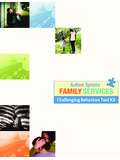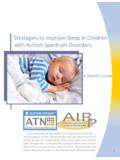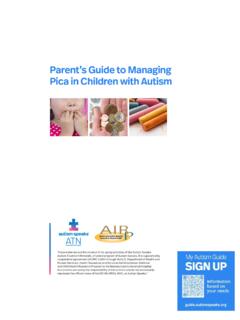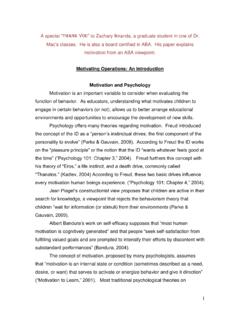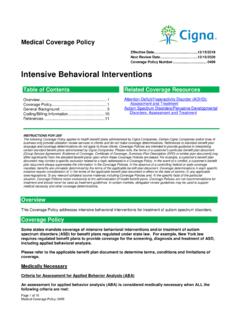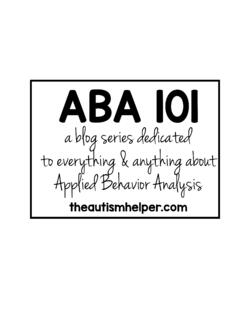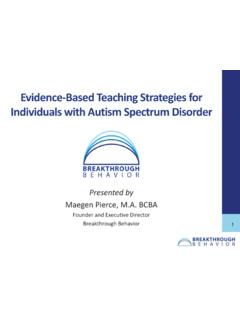Transcription of Parent’s Guide to Applied Behavior Analysis for Autism
1 Parent s Guide to Applied Behavior Analysis for AutismThese materials are the product of on-going activities of the Autism Speaks Autism Treatment Network, a funded program of Autism Speaks. It is supported by cooperative agreement UA3 MC 11054 through the Department of Health and Human Services, Health Resources and Services Administration, Maternal and Child Health Research Program to the Massachusetts General Hospital. Its contents are solely the responsibility of the authors and do not necessarily represent the official views of the MCHB, HRSA, HHS, or Autism Speaks. A Parent s Guide to Applied Behavioral Analysis WHAT IS ABA? ABA stands for Applied Behavior Analysis . ABA is a set of principles that form the basis for many behavioral treatments. ABA is based on the science of learning and Behavior . This science includes general laws about how Behavior works and how learning takes place.
2 ABA therapy applies these laws to Behavior treatments in a way that helps to increase useful or desired behaviors. ABA also applies these laws to help reduce behaviors that may interfere with learning or behaviors that may harmful. ABA therapy is used to increase language and communication skills. It is also used to improve attention, focus, social skills, memory, and academics. ABA can be used to help decrease problem behaviors. ABA is considered an evidence-based best practice treatment by the US Surgeon General and by the American Psychological Association. Evidence based means that ABA has passed scientific tests of its usefulness, quality, and effectiveness. ABA therapy includes many different techniques. All of these techniques focus on antecedents (what happens before a Behavior occurs) and on consequences (what happens after the Behavior ). One technique is positive reinforcement.
3 When a Behavior is followed by something that is valued (a reward), that Behavior is more likely to be repeated. ABA uses positive reinforcement in a way that can be measured in order to help bring about meaningful Behavior change. A few types of therapies based on ABA principles are discrete trial learning, incidental teaching (or natural environment training), verbal Behavior , pivotal response training, and natural language paradigm (see next page for details). All of these ABA-based therapies: Are structured Collect data for target skills or behaviors Provide positive strategies for changing responses and behaviors ABA focuses on positive reinforcement strategies. It can help children who are having difficulty learning or acquiring new skills. It can also address problem behaviors that interfere with functioning through a process called functional behavioral assessment.
4 The principles and methods of Behavior Analysis have been Applied effectively in many circumstances to develop a wide range of skills in learners with and without disabilities. ABA In a Nutshell Understanding (and modifying) Behavior in the context of environment is the basis for ABA therapies. " Behavior " refers to all kinds of actions and skills (not just misbehavior). "Environment" includes all sorts of physical and social events that might change or be changed by one's Behavior . This tool kit is an informational Guide to Applied Behavioral Analysis (ABA). It is designed to provide you with a better understanding of ABA, how your child can benefit, and where/how you can seek ABA services. p. 2 A Parent s Guide to Applied Behavioral Analysis EXAMPLE THERAPIES BASED UPON ABA Discrete Trial Learning (Training) is based on the understanding that practice helps a child master a skill.
5 It is a structured therapy that uses a one-to-one teaching method and involves intensive learning of specific behaviors. This intensive learning of a specific Behavior is called a drill. Drills help learning because they involve repetition. The child completes a task many times in the same manner (usually 5 or more). This repetition is especially important for children who may need a great deal of practice to master a skill. Repetition also helps to strengthen long-term memory. Specific behaviors (eye contact, focused attention and facial expression learning) are broken down into its simplest forms, and then systematically prompted or guided. Children receive positive reinforcement (for example: high-fives, verbal praise, and tokens that can be exchanged for toys) for producing these behaviors. For example, a therapist and a child are seated at a table and the therapist prompts the child to pay attention to her by saying look at me.
6 The child looks up at the therapist and the therapist rewards the child with a high-five. Incidental Teaching (or Natural Environment Training) is based on the understanding that it is important to give real-life meaning to skills a child is learning. It includes a focus on teaching skills in settings where your child will naturally use them. Using a child s natural everyday environment in therapy can help increase the transfer of skills to everyday situations and helps generalization. In Incidental Teaching, the teacher or therapist utilizes naturally occurring opportunities in order to help the child learn language. The activity or situation is chosen by the child, and the caregiver or teacher follows the child's lead or interest. These teaching strategies were developed to facilitate generalization and maximize reinforcement. Once naturally occurring situations in which a child expresses interest are identified, the instructor then uses graduated prompts to encourage responses from the child.
7 For example, a child is playing on the swings and needs the therapist to push him so that he can swing higher. The therapist waits on the child to ask for a push. Only after the child asks does the therapist push the swing. The therapist waits for the child to ask each time before he/she pushes the child again. Verbal Behavior is similar to discrete trial training in that it is a structured, intensive one-to-one therapy. It differs from discrete trial training in that it is designed to motivate a child to learn language by developing a connection between a word and its meaning. For some children, teaching a word or label needs to include a deliberate focus on teaching them how to use their words functionally ( What is this? A cup. What do you use a cup for? Drinking. What do you drink out of? A cup.) Pivotal Response Training is a naturalistic, loosely structured, intervention that relies on naturally occurring teaching opportunities and consequences.
8 The focus of PRT is to increase motivation by adding components such as turn-taking, reinforcing attempts, child-choice, and interspersing maintenance (pre-learned) tasks. It takes the focus off of areas of deficits and redirects attention to certain pivotal areas that are viewed as key for a wide range of functioning in children. Four pivotal areas have been identified: (a) motivation, (b) child self-initiations, (c) self management, and (d) responsiveness to multiple cues. It is believed that when these areas are promoted, they produce improvements in many of the non-targeted behaviors. The Early Start Denver Model is an early behavioral intervention model appropriate for children as young as 18 months of age. This model has a strong emphasis on Pivotal Response Training. Natural Language Paradigm (NLP) is based on the understanding that learning can be helped by deliberate arrangement of the environment in order to increase opportunities to use language.
9 NLP emphasizes the child s initiative. It uses natural reinforcers that are consequences related directly to the Behavior , and it encourages skill generalization. For example, a child who is allowed to leave after being prompted to say goodbye has a greater likelihood of using and generalizing this word when compared with a child who receives a tangible item for repeating this word. NLP transfers instruction from the therapy room to the child s everyday environment with the interest of the child serving as the starting point for interventions. p. 3 A Parent s Guide to Applied Behavioral Analysis ABA METHODS SUPPORT PERSONS WITH Autism IN A VARIETY OF WAYS: Teach skills to replace problem behaviors. So your child can learn what to do, not just what to stop doing. Increase positive Behavior and reduce interfering Behavior . For example, reinforcement procedures increase on-task Behavior or social interactions and reduce behaviors like self-injury or stereotypy.
10 Maintain behaviors. For example: Teaching self-control and self-monitoring procedures to maintain and generalize job-related social skills Change responses to your child s Behavior . These responses could unintentionally be rewarding problem Behavior . Increase your child s academic, social, and self-help skills. Improve ability to focus on tasks, comply with tasks, and increase motivation to perform. Aim to improve cognitive skills. Helps your child be more available for learning. Generalize or to transfer Behavior from one situation or response to another (For example, from completing assignments in the resource room to performing as well in the mainstream classroom). WHAT DOES ABA LOOK LIKE? ABA is such a broad approach that it is difficult to define what a typical program will look like. The amount of therapy and level of parent involvement varies, often according to the specific needs of the child.
